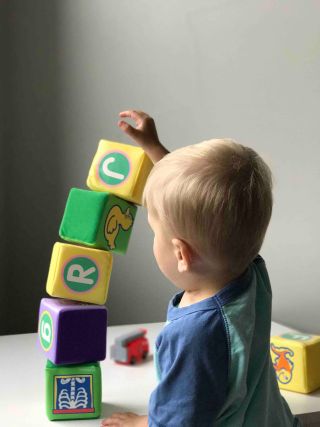Cognition
What Babies Know About Counting Numbers
Infants may not fully understand numbers, but have an innate sense of them.
Posted March 9, 2023 Reviewed by Lybi Ma
Key points
- Babies are paying attention when we count objects around them.
- They are good at telling the difference between a large and small group of items.
- Babies with better early counting ability score higher in later mathematics tests.
A red knot is a tiny shorebird that makes an epic 9000-mile journey all the way from the arctic to the tip of southern Chile and back. Biologists and nature enthusiasts congregate at various points along this journey to count these little birds. Novice bird counters begin by counting to 30, they get used to what that looks like from the ground. Then they build up to 50, 100, 1000, and maybe even 5000 birds. Counting birds is like a finely practiced art. Experts get to a point where they can count thousands at a glance and can do it from the ground or in the air flying alongside the birds. At a glance, can you tell how many birds there are in this picture?

In general, humans are good at counting; we have a keen mathematical sense and discriminate between quantities quite easily. We can tell that a group of 15 balls is more than five watermelons simply by glancing at them. And in case you were wondering, there are approximately 200 birds in that picture above.
At what age do we begin discriminating quantities? When does this powerful capacity emerge? Can babies count? Yes! Babies seem to have a much more sophisticated understanding of the world than we think. Several years before they can say and understand the words “one”, “two” and “three”, they appear to be counting.
Babies Pay Attention to Counting
In a study that came out in 2019, 14- and 18-month-old babies differentiated between two and four objects when these objects were counted. For example, babies watched researchers count four toy dogs saying “one, two, three, four! Four dogs!” before placing them inside a box. Later the babies could remove these dogs from the box. On some occasions, the babies removed two of the four dogs and were then led to believe that there were no more dogs inside the box. (The researchers removed the remaining two dogs when the child wasn’t looking). In all such instances, the babies searched for longer durations for the remaining two dogs—almost as if expecting there to be more objects inside the box.
When the researchers repeated the same exercise without counting (they simply placed the dogs inside the box without counting them), babies searched for shorter durations. They were distracted even after one object was removed from the box, almost as if there was nothing left to see. These toddlers demonstrated an understanding of the number of objects that were placed inside the box when they were counted. Researchers at Duke University have also tested this with younger infants, 6 months old, in a slightly different experimental paradigm, but they found a similar effect. Babies could tell the difference between eight and 16 numerical dots on a screen.

Does language matter? In a follow-up study, researchers repeated the same experiment—only this time, they counted in German instead of English. All of the babies were from English-speaking households and had not been exposed to German prior to the study. Yet the same effect was replicated. Babies searched inside the box for longer durations when they had seen the researcher count more objects than had been retrieved. They were not interested in retrieving objects from the box if they had not been counted before they were placed inside.
Babies Like Counting with Correspondence
A study conducted in Australia compared infants’ preference for counting with a correct vs. incorrect sequence. In the correct sequence, researchers counted six fish in serial order from one to six. In the incorrect sequence, they counted two fish over and over again until they got to six. Eighteen-month-olds preferred to watch the correct counting sequence that follows the principle of correspondence. This is interesting because one-to-one correspondence appears in almost every preschool mathematics curriculum, where children are taught that each object corresponds with one number. But it seems like toddlers acquire basic how-to-count principles way before counting has even begun.
Building Toddlers’ Number Sense
This early number sense in toddlers has been shown to be predictive of later mathematical abilities in children. Preverbal number sense in 6-month-olds predicted their math performance three years later. The ability to sense numbers even before they officially learn to count has several advantages. Counting a variety of concrete objects around them, following the principles of correspondence can be quite beneficial to infants. Any object around the home - such as blocks, cars, little bears, pieces of fruit, or circles on a wall can be used for counting. Simply ensuring that babies are watching while we count is an excellent starting point. Numbers are abstract, but babies seem to grasp them mentally and experientially when we count. Although their understanding of numbers may not be exact at first, counting does make a difference.
References
Slaughter, V., Itakura, S., Kutsuki, A., & Siegal, M. (2011). Learning to count begins in infancy: evidence from 18 month olds' visual preferences. Proceedings. Biological sciences, 278(1720), 2979–2984. https://doi.org/10.1098/rspb.2010.2602
Starr, A., Libertus, M. E., & Brannon, E. M. (2013). Number sense in infancy predicts mathematical abilities in childhood. Proceedings of the National Academy of Sciences of the United States of America, 110(45), 18116–18120. https://doi.org/10.1073/pnas.1302751110
Wang, J. J., & Feigenson, L. (2019). Infants recognize counting as numerically relevant. Developmental science, 22(6), e12805. https://doi.org/10.1111/desc.12805


